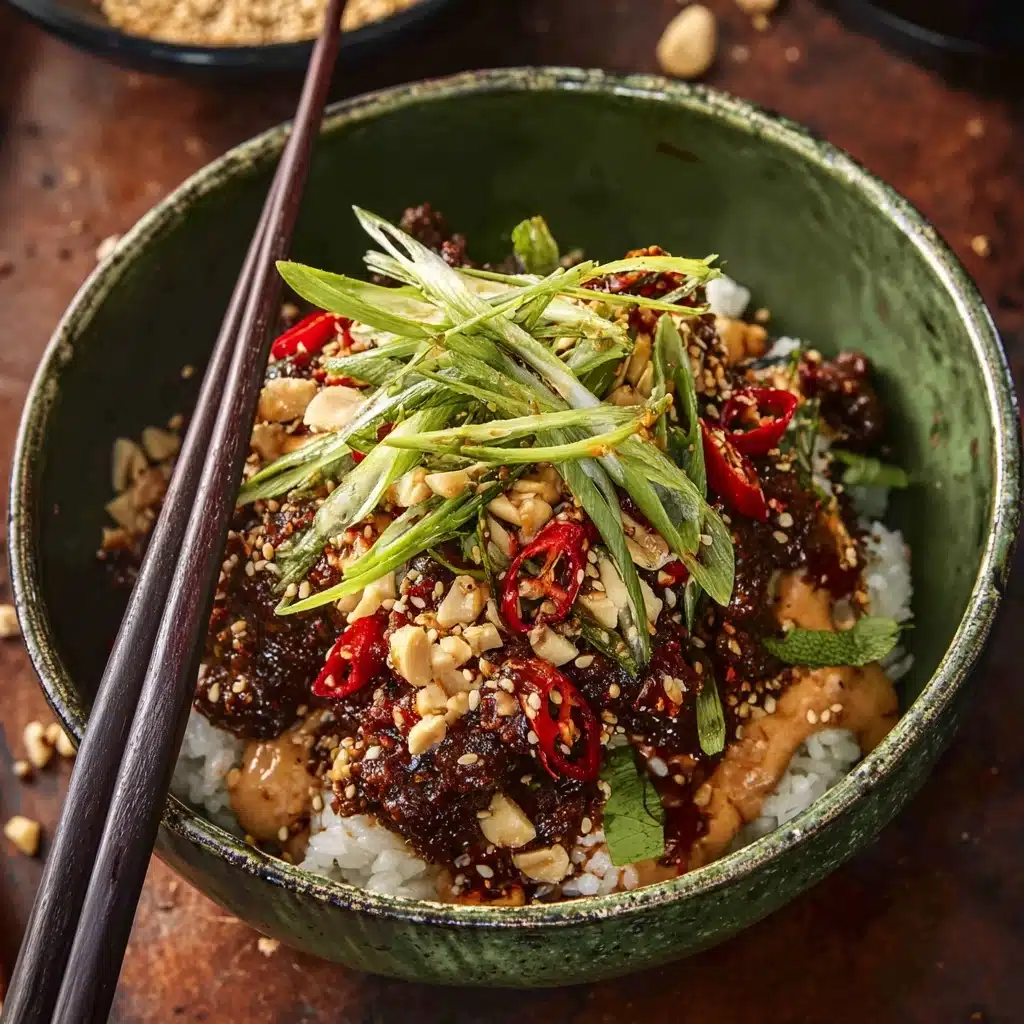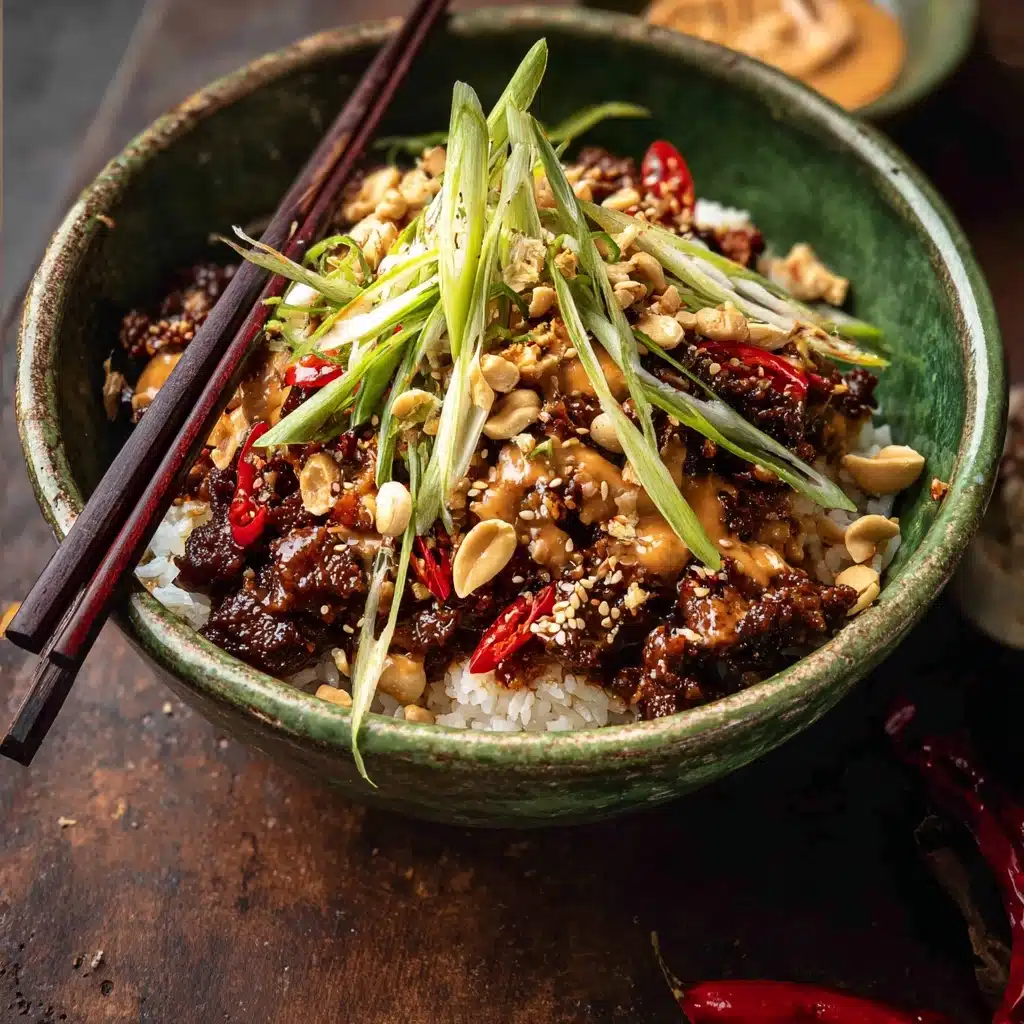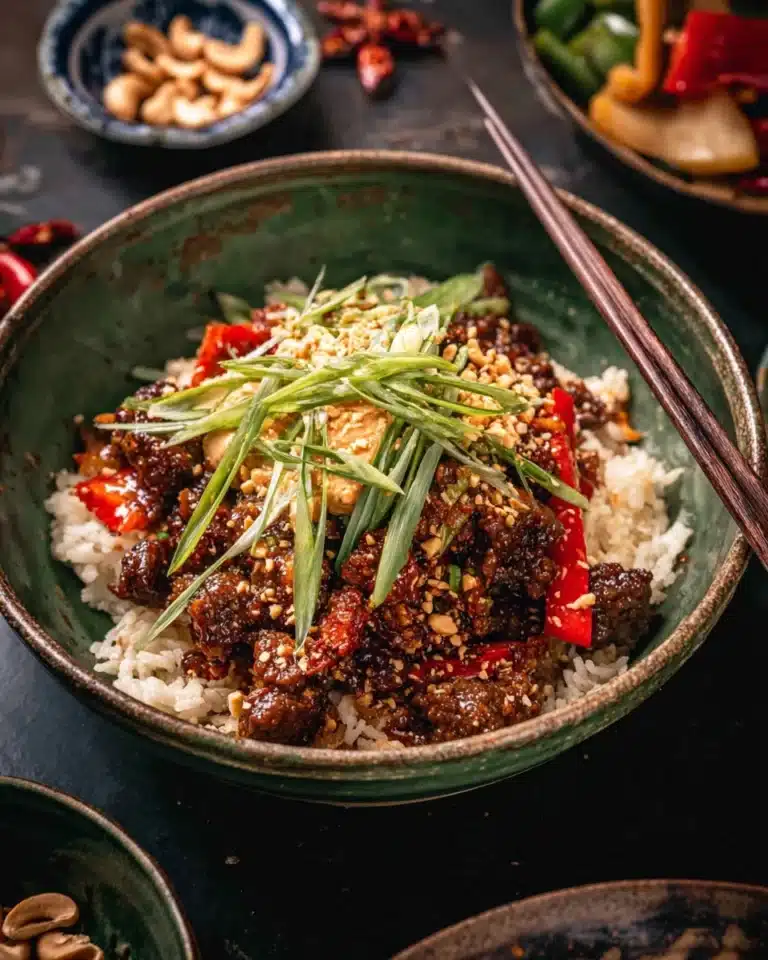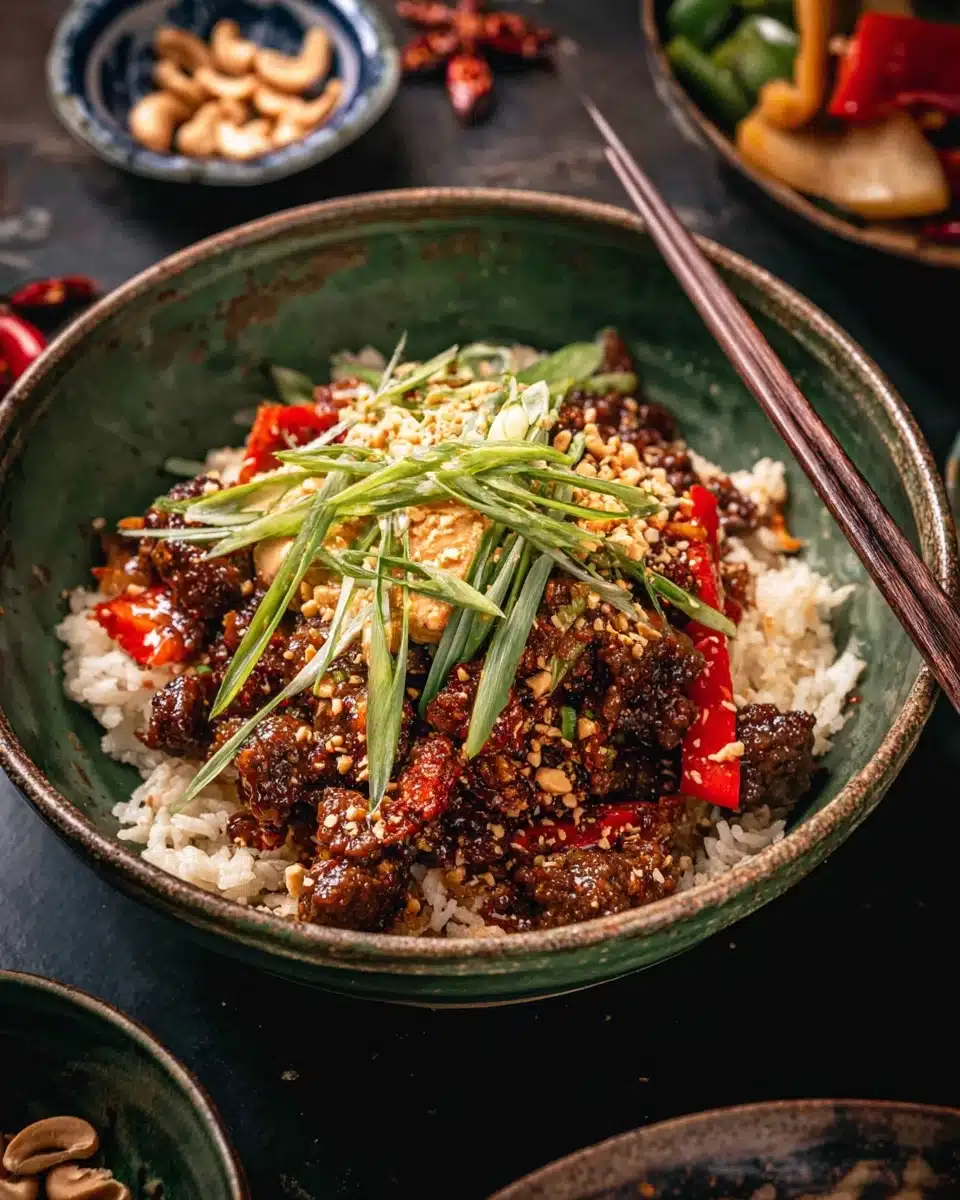If you’re in the mood for something fiery, fast, and full of flavor, these 20 Minute Korean Gochujang Beef Bowls are about to become your new weeknight addiction. The combination of savory ground beef, colorful peppers, and the sweet-spicy kick of gochujang all come together over fluffy rice, then get topped off with crunchy peanuts and a tangy cucumber salad. This dish is my go-to when I want a comforting yet punchy dinner that checks every box: easy, lively, and totally satisfying from the first bite.

Ingredients You’ll Need
The ingredient list for these 20 Minute Korean Gochujang Beef Bowls is short, sweet, and gets right to the point. Every component adds depth, texture, or that signature Korean-inspired zing, making these bowls truly pop. Let’s break down what you’ll need and why each item matters.
- Ground beef: Rich, juicy, and quick to cook, ground beef is the savory backbone of the dish.
- Butter: Adds a silky mouthfeel and helps brown the meat for a little extra luxury.
- Bell peppers: Their color and crunch lighten up the beef beautifully.
- Shallots: Provide a gentle sweetness that balances out the spicy sauce.
- Garlic: Packs in aromatic depth—a must for big flavor!
- Pickled or fresh ginger: Brings brightness and a cutting zing that wakes up your palate.
- Tamari or soy sauce: Adds the essential salty umami backbone.
- Gochujang (Korean chili paste): The soul of the dish—fermented, spicy, and slightly sweet.
- Ginger juice: Extra ginger intensity! Use the fresh stuff or bottle for convenience.
- Maple syrup or honey: Balances the heat with gentle sweetness.
- Toasted sesame seeds: The nutty crunch is non-negotiable for finishing the bowls.
- Chopped roasted peanuts: An optional but delightful textural topping.
- Persian cucumbers: Their crispness shines in the cooling salad.
- Green onion/Thai basil: These herby finishing touches bring freshness to every bite.
- Rice vinegar or more ginger juice: Adds acidity and liveliness to the cucumber salad.
- Steamed rice (for serving): Fluffy rice soaks up every last drop of flavor.
How to Make 20 Minute Korean Gochujang Beef Bowls
Step 1: Brown the Beef
Start by heating a large skillet over medium heat, then add your ground beef and a little black pepper. As soon as the beef hits the pan, listen for that satisfying sizzle. Use a wooden spoon to break up the meat and keep things moving—after about five minutes, you’ll see the beef beautifully browned and almost cooked through.
Step 2: Add Flavor and Vegetables
Once the beef is browned, add in the butter, sliced bell peppers, chopped garlic, shallots, and ginger. Let everything cook together for a couple of minutes. The butter transforms the pan juices into a flavorful, glossy coating while the veggies soften just enough to stay crisp, their colors brightening up the pan.
Step 3: Sauce It Up
Time for the magic! Pour in the tamari or soy sauce, spoon in the gochujang, pour in the ginger juice, and add a splash (about 1/3 cup) of water. Stir everything to coat the beef and vegetables. Allow it to simmer for a few minutes so the sauce thickens and clings to every bit of meat and pepper.
Step 4: Sweeten and Finish
Now comes the secret to that glossy, caramelized finish: Stir in your maple syrup or honey and let the mixture cook another 1-2 minutes. As the beef caramelizes, the kitchen will start to smell absolutely incredible! Once the sauce looks luscious and thick, turn off the heat and sprinkle in those toasted sesame seeds for nutty aroma and crunch.
Step 5: Make the Cucumber Salad
While the beef cooks, toss together your chopped cucumbers with a generous pinch of salt, a little gochujang, ginger juice or a splash of rice vinegar, and fresh herbs like green onion or Thai basil. Give the salad five minutes—just enough time for everything to mingle and mellow.
Step 6: Assemble the Bowls
Spoon steamy, hot rice into bowls, then pile on the beef and peppers. Top each with a scoop of that tangy cucumber salad, a shower of chopped peanuts, and extra herbs if you like. Don’t forget a drizzle of spicy mayo if you love a little extra richness!
How to Serve 20 Minute Korean Gochujang Beef Bowls

Garnishes
This is where creativity counts: a big sprinkle of roasted peanuts, a handful of fresh herbs, extra sesame seeds, and maybe a zigzag of spicy mayo will make these 20 Minute Korean Gochujang Beef Bowls pop with flavor and color. Serve lime wedges alongside for a squeeze of brightness—every garnish adds a layer of personality.
Side Dishes
These bowls are fabulously hearty as-is, but you can always round out your table with a simple miso soup, crispy kimchi pancakes, or steamed edamame. If you crave more veg, try a quick sautéed bok choy or a kimchi plate for extra tang and crunch.
Creative Ways to Present
For a party or meal prep, try serving these in individual meal prep containers, or even in lettuce cups for a fun, low-carb spin. Layer the components in mason jars for an impressive picnic lunch, or offer a “build your own bowl” bar so everyone can assemble their perfect version of 20 Minute Korean Gochujang Beef Bowls.
Make Ahead and Storage
Storing Leftovers
Let the beef mixture cool to room temperature before transferring to an airtight container. Store in the refrigerator for up to 4 days. Keep the cucumber salad in a separate container to maintain its crunch.
Freezing
The beef and veggie mixture freezes beautifully—just pop it into freezer-safe bags or containers for up to 2 months. Thaw in the refrigerator overnight and make a fresh batch of cucumber salad when you’re ready to enjoy those 20 Minute Korean Gochujang Beef Bowls again.
Reheating
Reheat the beef gently on the stove or in the microwave with a splash of water or more tamari to refresh the sauce. The rice can be revived with a sprinkle of water and a quick zap in the microwave. Top with freshly made cucumber salad and peanuts for the full effect.
FAQs
What is gochujang and can I substitute it?
Gochujang is a Korean fermented chili paste that’s spicy, savory, and a little sweet. If you can’t find it, a mix of sriracha with a bit of miso paste and honey can work in a pinch, though the flavor won’t be exactly the same.
Can I make these bowls vegetarian?
Absolutely! Use crumbled tofu or tempeh in place of beef, and add extra vegetables like mushrooms or zucchini for a satisfying meatless meal.
How spicy are the 20 Minute Korean Gochujang Beef Bowls?
The spice level depends on how much gochujang you use. They’re zippy but not mouth-burning—start with less if you’re sensitive and add more to taste.
What kind of rice works best?
Short-grain white rice or jasmine rice are both delicious here, but you can use brown rice, cauliflower rice, or even serve with noodles for a fun twist.
Can I use other proteins?
Totally! Ground chicken, turkey, or even pork all work nicely in these 20 Minute Korean Gochujang Beef Bowls. Each option brings its own character and deliciousness.
Final Thoughts
I can’t recommend these 20 Minute Korean Gochujang Beef Bowls enough—they’re bold, bright, ooze with personality, and guarantee happy, full bellies. If you need a quick and memorable meal in your back pocket, this one delivers every single time. Give it a try, and let it become your new favorite too!
Print
20 Minute Korean Gochujang Beef Bowls Recipe
These 20 Minute Korean Gochujang Beef Bowls are a fast, flavorful weeknight dinner bursting with sweet-spicy Korean flavors. Juicy ground beef is caramelized in a gochujang-soy glaze, tossed with peppers and aromatics, and served over fluffy rice with a refreshing cucumber salad and crunchy peanuts for the ultimate satisfying bowl.
- Total Time: 20 minutes
- Yield: 6 servings
Ingredients
Main Beef Bowl
- 1 1/2 pounds ground beef
- 2 tablespoons butter
- 2 bell peppers, sliced
- 3 shallots, sliced
- 4 cloves garlic, chopped
- 1/4 cup pickled ginger (or 1 tablespoon fresh grated ginger)
- 1/2 cup tamari or soy sauce
- 2–3 tablespoons gochujang (Korean chili paste)
- 2 tablespoons ginger juice
- 2 tablespoons maple syrup or honey
- 1/4 cup toasted sesame seeds
- 1/3 cup chopped roasted peanuts
Cucumber Salad
- 4 Persian cucumbers, chopped
- 1 tablespoon gochujang (Korean chili paste)
- 1/4 cup chopped green onion or Thai basil
- 2 tablespoons ginger juice or rice vinegar
Instructions
- Brown the Beef: In a large skillet, combine the ground beef and a pinch of black pepper. Cook over medium heat, breaking up the meat as it cooks, until browned and cooked through, about 5 minutes.
- Saute Aromatics and Peppers: Add the butter, sliced bell peppers, chopped garlic, sliced shallots, and ginger (pickled or fresh). Stir and cook for 2 minutes until fragrant and beginning to soften.
- Add the Sauce: Pour in the tamari or soy sauce, gochujang, ginger juice, and 1/3 cup water. Stir to combine. Cook for 2-3 minutes, allowing the sauce to thicken and coat the beef.
- Caramelize and Finish: Mix in the maple syrup or honey. Continue cooking for another 1-2 minutes, stirring frequently, until the beef is beautifully glazed and caramelized. Remove from heat and toss with toasted sesame seeds.
- Make the Cucumber Salad: In a medium bowl, combine the chopped cucumbers, gochujang, green onions or Thai basil, and ginger juice or rice vinegar. Add 1 teaspoon salt. Mix well and let sit for 5 minutes to marinate.
- Assemble the Bowls: Serve the beef and pepper mixture over bowls of cooked rice. Top with the cucumber salad, sprinkle with chopped peanuts, and add spicy mayo if desired. Enjoy immediately!
Notes
- You can substitute ground chicken, pork, or turkey for beef if preferred.
- Adjust gochujang quantity to your preferred spice level – use less for milder bowls and more for extra heat.
- If ginger juice is unavailable, use freshly grated ginger for a punch of flavor.
- For a low-carb version, serve over cauliflower rice or lettuce wraps.
- Peanuts can be replaced with cashews or omitted for nut allergies.
- Prep Time: 10 minutes
- Cook Time: 10 minutes
- Category: Main-course
- Method: Stovetop
- Cuisine: Korean-inspired
- Diet: Halal
Nutrition
- Serving Size: 1/6 of recipe
- Calories: 430
- Sugar: 8g
- Sodium: 1350mg
- Fat: 28g
- Saturated Fat: 9g
- Unsaturated Fat: 16g
- Trans Fat: 0.5g
- Carbohydrates: 18g
- Fiber: 2g
- Protein: 27g
- Cholesterol: 85mg

